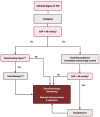Traumatic Brain Injury-A Review of Intravenous Fluid Therapy
- PMID: 34307515
- PMCID: PMC8299062
- DOI: 10.3389/fvets.2021.643800
Traumatic Brain Injury-A Review of Intravenous Fluid Therapy
Abstract
This manuscript will review intravenous fluid therapy in traumatic brain injury. Both human and animal literature will be included. Basic treatment recommendations will also be discussed.
Keywords: TBI; colloid; crystalloid; fluid therapies; hypertonic saline; mannitol; osmotherapy; traumatic brain injury.
Copyright © 2021 Pigott and Rudloff.
Conflict of interest statement
The authors declare that the research was conducted in the absence of any commercial or financial relationships that could be construed as a potential conflict of interest.
Figures

References
-
- The blood–brain barrier in health and disease. Ann Neurol Bas, kaya MK, Rao AM, Dog?an A, Donaldson D, Dempsey RJ. The biphasic opening of the blood-brain barrier in the cortex and hippocampus after traumatic brain injury in rats. Neurosci Lett. (1997) 226:33–36. 10.1016/S0304-3940(97)00239-5 - DOI - PubMed
Publication types
LinkOut - more resources
Full Text Sources

